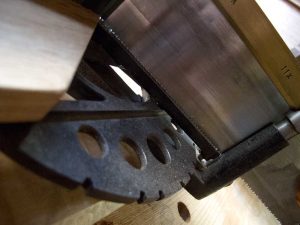We may receive a commission when you use our affiliate links. However, this does not impact our recommendations.
“(E)xtreme care is always requisite for proper mitring, in order that the beveled ends formed by sawing in the box may fit to form the angle required without planing, which is rarely done neatly enough to make a close joint and causes much waste of time.”
— “How to Join Mouldings; or, The Arts Of Mitring and Coping” by Owen B. Maginnis, 1892
I’ll not forget the first time I saw Glen D. Huey cut glass for a curved opening.
With the glass on a moving blanket, Glen drew the shape he wanted. And then he just cut it. No fence. No guide. He just went for it.
The glass fit just right and Glen said he learned to cut glass that way from a glass-cutter. Well, “learned” is a stretch. The glass-cutter dude simply told Glen to “go for it.” The rest was all Glen.
I think about that story a lot when I’m working with hand tools. When I get into some fussy operation, my inclination is to make a quick jig or guide to help me hit the mark. But about five years ago I decided to stop planing my miters after studying Joseph Moxon’s “Mechanick Exercises.”
So I started channeling Glen and Joe Moxon. And my miters are tighter and fit right off the saw about 90 percent of the time. Sometimes I’ll just lay out the miter on my stock and cut it on a bench hook. Other times I’ll use a miter box. But either way, I just go for gold by putting a tooth next to my knife line and diving in.
The less I think about the joint, the tighter the miters are. The less I worry about planing them, the less planing I have to do. The less that I consider mitering a difficult task, the easier it is.
Sure, you have to learn to saw, but that’s a given for this craft. And even beginning sawyers get good enough to do this after a couple days of learning to saw and cut dovetails.
So give it a try. Put the blast shield over your eyes and remember what Obi Wan said: “Your eyes can deceive you. Don’t trust them. Stretch out with your feelings.”
— Christopher Schwarz
If you are interested in getting better with your hand tools, I have a DVD set called “Mastering Hand Tools” that covers saws, planes and many other tools. It’s available in ShopWoodworking.com here.
Here are some supplies and tools we find essential in our everyday work around the shop. We may receive a commission from sales referred by our links; however, we have carefully selected these products for their usefulness and quality.










My first corner is always great, 100% of the time. The mate and the other end always seem to escape me.
aH, Hah!
Your last picture’s label implies that you used a commercial miter box to make your most excellent fitting cut. No fair, Yoda, you have a “jig” on that saw – and, as I suspected all along – a laser range finder on that light saber. The Force my ass.
Yeah, yeah, a hand powered commercial jig, but a jig none the less.
My Dad had one of those when I was a wee lad. Even at 7 years old I could cut decent miters for picture frames when using his jig but made kindling when using the hand saw.
Ah yes, but how do you get the knife line in the right place?
“Do, or do not. There is no try plane.”–Yoda